U.S.
Highways in Minnesota
Jump to Interstate Routes below.
Jump to lists of U.S. and Interstate routes.
History of the U.S. highway system. The U.S. highway
system was overlaid on the existing Minnesota trunk highway
system in 1927. Also, as noted in the listings below, there were
a few short segments of U.S. highway that were marked over county
roads. Until the great renumbering of 1934, U.S. highways were
marked with both the U.S. route and the trunk highway
(constitutional route) numbers. Even though there were no defined
constitutional routes through Minneapolis, St. Paul or Duluth,
U.S. routes were marked through the cities to provide route
continuity, just as extensions of the trunk highways terminating
at the city limits had been before that time.
The original east-west U.S. routes were 2,
8, 10 (and its N and S
branches between Moorhead and St. Cloud), 12, 14,
16, 210, and 212;
and north-south routes were 55, 61,
71, 75, and 218.
Reflecting the nationwide changes in the U.S. highway system in
its first few years of existence, new routes were soon extended
into Minnesota: 77 (briefly duplexed with 12
near the South Dakota border) was added about 1930; the entirely
intra-state 371 was established in 1931 and 169
was extended into the state in 1932. It should be noted
that U.S. 169 originally followed Constitutional Route 11 north
from Virginia to International Falls, now part of the route of
U.S. 53.
1934 was a year of change for both the Minnesota trunk highway
and U.S. highway networks. Minnesota began to mark the additional
routes added by the legislature in 1933, which required a major
redesign of the numbering system. No longer was there a strict
correlation between constitutional or legislative and marked
trunk highway number, and U.S. routes were no longer marked
separately with the constitutional route number. At the same
time, there were major changes in the U.S. highway numbering
system that affected the state.
Maps from the year 1934 show discrepancies in the intended
marking system for U.S. highways, as well as for those
state-numbered trunk highways with numbers the same as later
adopted for U.S. routes. My guess is that there were at least two
iterations of the highway marking plan, one of which may have
been prematurely distributed to map distributors. First to go was
the 10S/10N split. A 1934 Gousha map (not of Minnesota
exclusively, but rather a large-scale U.S. map on the back of
another state's map) shows 10S and 10N replaced by 10 and an
extension of 218 respectively. On this map, U.S. 210 is
(curiously) replaced by U.S. 208, which would not have been
consistent with the numbering scheme. The 1934 Wisconsin travel
map also shows this marking. However, this route was apparently
never marked as such, since after the map was initially redrawn,
U.S. 52 replaced U.S. 55 and was extended northwest to North
Dakota. 1934 and later maps still show U.S. 210.
The 1934 official Minnesota highway map shows the following
changes:
- U.S.
55 replaced by U.S. 52. 52 had
previously ended in Illinois.
- Northwest
of the Twin Cities, 10S and 10N
were replaced by 52 and 10
respectively.
- U.S.
212 has been rerouted from its original terminus
at Willmar along a more southerly alignment, and now goes
all the way to St. Paul and east to the Wisconsin border.
- U.S.
218 has been extended from its terminus at
Owatonna to St. Paul, then as MN-218 follows U.S. 10 to
Big Lake just as it did for many years. (The first
apparent draft plan described above to extend 218 to
Moorhead may explain the somewhat curious past routing of
MN-218 from St. Paul to Big Lake then north along a
somewhat minor road --- now MN-25 --- to Brainerd).
- U.S.
65, which formerly ended at St. Paul, was
re-routed to Minneapolis, and north to U.S. 2 at Swan
River.
- Another
change shown on this map: trunk highway 59 from the Iowa
border to Lake City is shown as U.S. 59.
Now, at that time 59 did not exist, and it is possible
that this was a proposal to create a U.S. highway from
Iowa to Minnesota that fortuitously could utilize the
former marked route number.
- U.S.
210 is unchanged despite the other map's representation.
According to Minnesota Highway News, official
publication of the Minnesota Highway Department, these routes
were marked until the 1935 changes described below took place.
In 1935, some of the changes above were changed again. U.S.
63 is now marked along ConRt. 59, and U.S. 59
is in its present location in western Minnesota (along the route
originally designated MN-73). Also, U.S. 69 has
been extended north from Iowa. The extensions north and east of
the Twin Cities of U.S. 65 and 212, and the extension to St. Paul
of U.S. 218, are marked as state-numbered routes instead. My
speculation is that Minnesota anticipated approval from AASHO
(predecessor to AASHTO) for its proposed U.S. route changes, and
had to retract the U.S. 65, 212 and 218 extensions, and original
U.S. 59.
The coming of the interstate system has resulted in U.S.
routes being either decomissioned because of their redundancy, or
hidden where adjoining states can't be convinced to agree to a
decommissioning. U.S. 8 was decommissioned
between Forest Lake and Minneapolis; U.S. 65 was
eliminated north of Albert Lea; U.S. 61 removed
north of Wyoming (soon to be cut back to St. Paul); and U.S.
16 done away with east of Rapid City SD in its entirety.
Minnesota can't convince North Dakota to eliminate U.S.
52, so MnDOT runs it along I-94 and simply doesn't mark
it. U.S. 12 between Minneapolis and the
Wisconsin border is similarly hidden.
There have never been U.S. routes with ALTERNATE or BYPASS
designations in Minnesota. However, there is currently one
BUSINESS route in the trunk highways system (U.S. 2 Business at
East Grand Forks). Previously, there were Business routes in the
trunk highway system of U.S. 169 at Hibbing (co-signed with
MN-73) and U.S. 53 at Virginia (co-signed with MN-135). Both of
these routes have been turned back to the respective cities.
Interstate routes
The interstate system is much as originally planned, except
for changes in highway alignments. Major differences in what was
actually built versus originally proposed are that I-335 around
the north side of downtown Minneapolis never was built, and I-394
was built instead; and I-35 does not extend all the way through
Duluth to connect with the highway 61 expressway northeast of
that city as the original plan intended.
Lists of U.S. and Interstate Highways
List of past and present U.S. and Interstate highways in
Minnesota. Details on these routes can be accessed from the
"explore route" pages. Direct links for each route to
the route detail pages are now active. Background of table row
indicates route currently exists or era of decommissioning as
follows:
| Currently
authorized and marked routes |
| Routes
decommissioned 1973-80 |
| Route decomissioned in the 1960s |
| Routes
decommissioned in the 1930s |
| U.S. routes proposed and printed on maps
but probably never actually marked, or Interstate route
proposed but defeated by public opposition. |
| Route
|
Approx.
year introduced |
Major changes
in length or routing, and year decommissioned |

|
1926
|
Original
route ran due east from Floodwood to TH-11 (now U.S. 53)
along what is now CSAH 8 until about 1933. Point of
entry to Duluth and route to Wisconsin changed in 1934 |

|
1926
|
Originally
terminated at U.S. 61 at Wyoming, extended to Minneapolis
around 1931, has terminated at I-35 at Forest Lake since
1980. Alignment change about 1955 between Chisago City
and U.S. 61 when U.S. 8 was routed onto former MN-98 to
Forest Lake. The old alignment of U.S. 8 to Wyoming
became MN-98. |

|
1926
|
Replaced
U.S. 10N in 1934, routing from St. Paul to Wisconsin
(originally duplexed with U.S. 12) changed in 1934 |
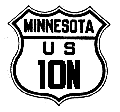
|
1926
|
Replaced
by U.S. 10 in 1934 |
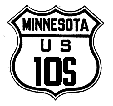
|
1926
|
Replaced
by U.S. 52 in 1934 Part of original route was on
county road rather than trunk highway.
|

|
1926
|
Route
essentially unchanged. Not marked east of junction with
I-494 where it becomes concurrent with I-394. Part
of original route was on county road rather than trunk
highway.
|

|
1926
|
Extended
east into Wisconsin from U.S. 61 at Winona in 1933.
Otherwise, route essentially unchanged |

|
1926
|
Decommissioned
1980; replaced by I-90 and MN-16 |

|
1934
|
Route
between Minneapolis and St. Cloud changed around 1984.
Only marked on independent segment south of St. Paul, not
along I-94. |

|
1934
|
Route
essentially unchanged |
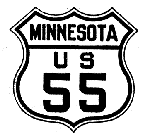
|
1926
|
Replaced
by U.S. 52 southeast of Farmington, by U.S. 65 northwest
of Farmington in 1934 |
| Original
route of 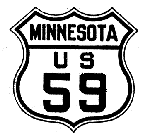
|
1934
|
Originally
proposed, and printed as such on official 1934 Minnesota
highway map, to run along Constitutional Route 59
(present-day U.S. 63) between Iowa border south of Spring
Valley to U.S. 61 at Lake City. Evidently posted for one
year, until U.S. 63 was extended north from southern Iowa
in 1935 into Minnesota, and U.S. 59 was instead used for
a Texas-Minnesota route along its current alignment
(marked on that 1934 map as MN-73). |

|
1935
|
The
only route change on the current route is the segment
between Lancaster and Canadian border. The original route
ran from Lancaster west to St. Vincent MN and into North
Dakota until the mid-1950s. |

|
1926
|
No
significant changes south of Wyoming. Decommissioned
about 1991 north of Wyoming, replaced by I-35 and MN-61. |

|
1935
|
Route
essentially unchanged |

|
1926
|
1934:
replaced between Farmington and St. Paul by MN-218 and
MN-88, re-routed along former U.S. 55 to downtown
Minneapolis. c. 1958: Between Faribault and Lakeville,
re-routed along former MN-165. Old alignment became
MN-218 only.
1983: Decommissioned north of Albert Lea
|

|
1935
|
Route
essentially unchanged |

|
1926
|
New
alignment in 1934 between Willmar and Sauk Centre |

|
1926
|
New
alignment between Moorhead and Crookston along old MN-81
around 1955. |
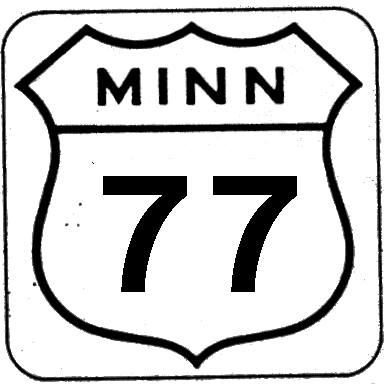
|
1930 |
May have been duplexed with U.S. 12 in
South Dakota to U.S. 75 in Minnesota until the late
1960s. Shown as such on 1965 Minnesota Highway Map. Was
only present in Minnesota duplexed with U.S. 12 for a
short distance. |

|
1932
|
Originally
routed along C.R. 11 from Virginia to Int'l Falls,
terminated at Virginia in 1934 when U.S. 53 introduced.
New alignment between Mankato and St. Peter around 1961.
Several alignment changes in Twin Cities area 1978-96. |
| Proposed 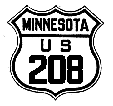
|
1934 |
A proposed replacement for U.S. 210
published on at least two different 1934 maps (but not on
any official Minnesota highway map). The unusual
designation probably would have been because the western
terminus would no longer have been U.S. 10, though it
would have been a non-standard number in an era when U.S.
routes were uniformly standard. See U.S. 218 extension
below for whole story. |

|
1926
|
Decommissioned
1973 |

|
1926
|
Former
alignment from Montevideo to Willmar (along present-day
MN-7 and MN-23) replaced in 1934 by current route to Twin
Cities. Decommissioned in the Twin Cities area east of
U.S. 169 around 1983. Part of original route was on
county road rather than trunk highway.
|

|
1926
|
Route
essentially unchanged from original routing, except that
it extended from Owatonna to St. Paul along the original
route of U.S. 65 from 1934 to 1935. (This then became
MN-218) |
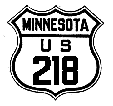 extension northwest
of St. Paul extension northwest
of St. Paul |
1934 |
As noted above, from 1934 to 1935, U.S.
218 did extend from Owatonna to St. Paul before it was
changed to MN-218. However, the original proposed
1934 numbering plan went much further. U.S. 218 was proposed to extend from St.
Paul to Fargo along the alignment of U.S. 10 (to St.
Cloud) and then along what had been U.S. 10N. The same
map shows U.S. 10S becoming U.S. 10, and U.S. 210
becoming U.S. 208. This plan was evidently scrapped when
U.S. 52 was extended north into Minnesota and occupied
the route of former U.S. 10S. Instead, the
extension northwest of St. Paul was re-routed to Brainerd
along a new legislative route (today’s MN-25) and
was designated MN-218. The entire route north of Owatonna
was converted to a state-numbered route in 1935.
|

|
1932
|
Route
decommissioned 1973. |
Interstates
| Primary
routes and Associated
3di routes
|
Coincident
U.S. Routes: Decommissioned
Multiplexed & marked
Multiplexed & not marked
|
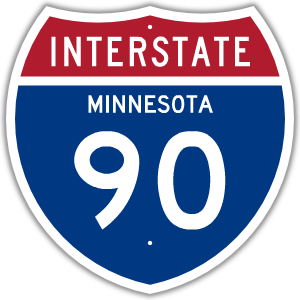 |
16
- SD Border to MN-16 E of Austin |
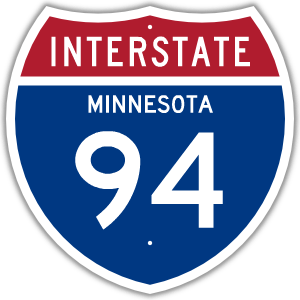 |
52 - ND Border to
St. Paul 10 - Jct. I-35E to Jct. U.S. 10/61
south
12 - Jct.
I-394 in Minneapolis to WI Border
|
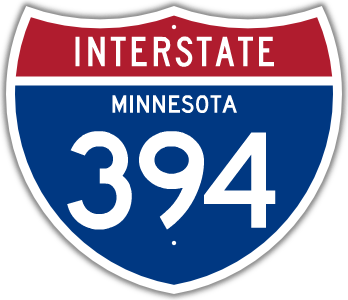
|
12 - Jct. I-494 to
Jct. I-94 |
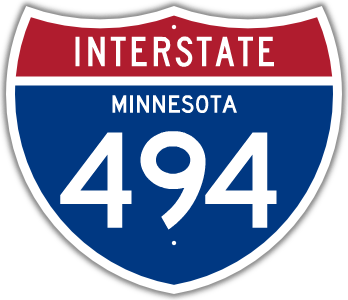
|
|
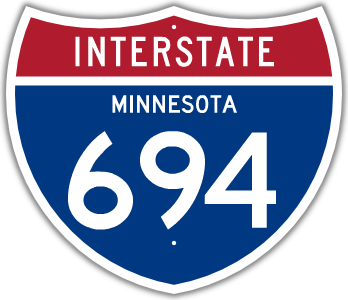
|
52 - Multiplexed
segment with I-94 10 - Jct. U.S. 10 to Jct.
I-35E
|
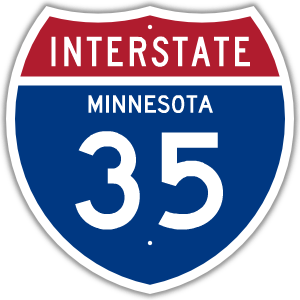 |
65
- Albert Lea to I-35W 8 - Jct. I-35W
to Jct. U.S. 8
61 - Wyoming to Duluth
|
Proposed
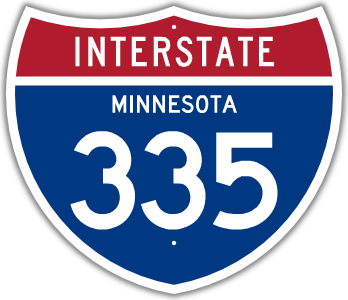
|
Proposed link through northeast
Minneapolis between I-35W and I-94 north of downtown.
Scrapped due to public opposition. View map of proposed I-335
|
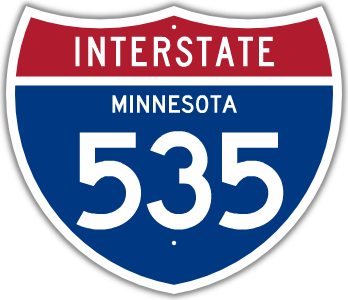
|
53
- Entire length |
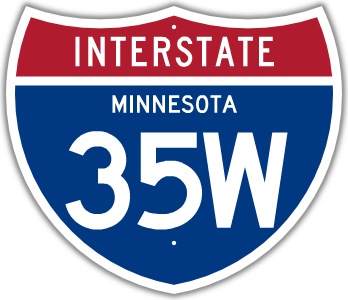 |
65
- Jct. I-35 to Minneapolis 8 - Jct.
Ramsey CSAH 88 to Jct. I-35
|
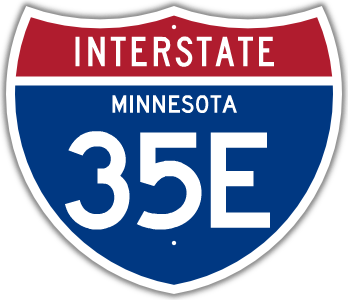 |
10
- Jct. I-94 to Jct. I-694 |
Return to
Minnesota Highways Home Page
First uploaded February 28 1998
Updated July 12, 2010


 extension northwest
of St. Paul
extension northwest
of St. Paul
































